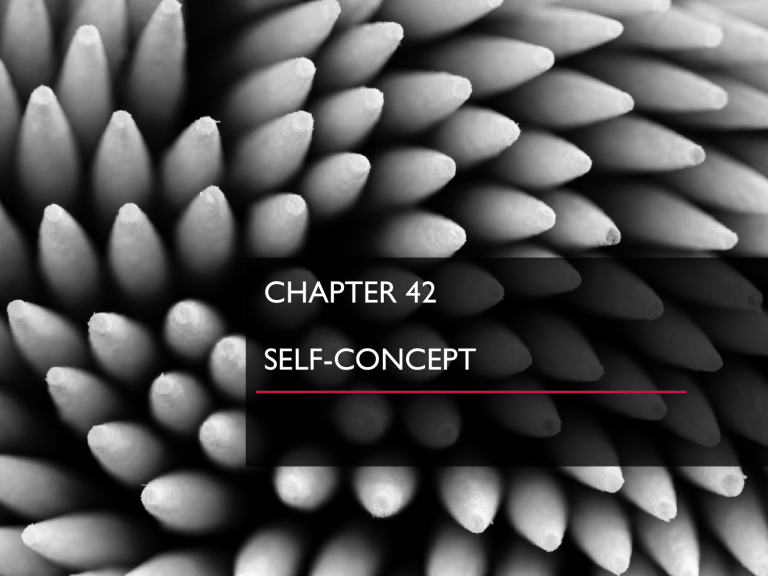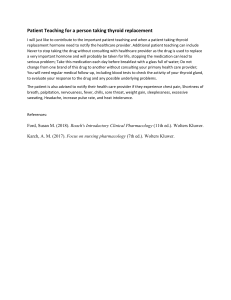
CHAPTER 42 SELF-CONCEPT Copyright © 2011 Wolters Kluwer Health | Lippincott Williams & Wilkins Copyright © 2023 Wolters Kluwer • All Rights Reserved DIMENSIONS OF SELF-CONCEPT • Self-knowledge: “Who am I?” • Self-expectation: “Who or what do I want to be?” • Self-evaluation: “How well do I like myself?” Copyright © 2023 Wolters Kluwer • All Rights Reserved MASLOW’S SUBSETS OF ESTEEM NEEDS • Self-esteem: Strength, achievement, mastery and competence, confidence in the face of the world, independence, freedom • Respect needs: Status, dominance, recognition, attention, importance, appreciation Copyright © 2023 Wolters Kluwer • All Rights Reserved Significance- the way one feels loved by important to them COOPERSMITH’S (1967) FOUR BASES OF SELF-ESTEEM Competence- tasks that are considered important when performed Virtue- attainment of moralethical standards Power – influence their own on others lives Copyright © 2023 Wolters Kluwer • All Rights Reserved THREE MAJOR SELFEVALUATION FEELINGS • Pride: based on positive self-evaluation • Guilt: based on behaviors incongruent with the ideal self • Shame: associated with low global selfworth Copyright © 2023 Wolters Kluwer • All Rights Reserved FORMATION OF SELF-CONCEPT • Infant learns physical self different from environment. • If basic needs are met, child has positive feelings of self. • Child internalizes other people’s attitudes toward self. • Child or adult internalizes standards of society. Copyright © 2023 Wolters Kluwer • All Rights Reserved STAGES IN DEVELOPMENT OF SELF • Self-awareness (infancy) self different from environment • Self-recognition (18 months) • Self-definition (3 years) • Self-concept (6–7 years) Copyright © 2023 Wolters Kluwer • All Rights Reserved FACTORS AFFECTING SELFCONCEPT • Developmental considerations • Culture • Internal and external resources • History of success and failure • Crisis or life stressors • Aging, illness, disability, or trauma Copyright © 2023 Wolters Kluwer • All Rights Reserved • Personal identity (person description of who they are) • Personal strengths ASSESSING SELFCONCEPT • Body image (subjective view about their physical body) adaptive and maladaptive response • Self-esteem (how they feel about themselves) real and ideal • Role performance (socialetal role vs role demands) Copyright © 2023 Wolters Kluwer • All Rights Reserved ASSESSING SELF-ESTEEM • Socialization and communication • Significance • Competence • Virtue • Power Copyright © 2023 Wolters Kluwer • All Rights Reserved CONTINUUM OF SELF-CONCEPT RESPONSES Copyright © 2023 Wolters Kluwer • All Rights Reserved NURSING STRATEGIES TO IDENTIFY PERSONAL STRENGTHS • Encourage patients to identify their strengths • Replace self-negation with positive thinking • Notice and reinforce patient strengths • Encourage patients to will for themselves • Help patients cope with necessary dependency Copyright © 2023 Wolters Kluwer • All Rights Reserved HELPING PATIENTS MAINTAIN SENSE OF SELF • Communicate worth with looks, speech, and judicious touch. • Acknowledge patient status, role, and individuality. • Speak to the patient respectfully. Address by preferred name • Converse with the patient about their life experiences • Offer simple explanations for procedures. • Move the patient’s body respectfully, if necessary. • Respect the patient’s privacy and sensibilities. • Acknowledge and allow expression of negative feelings. • Help the patient recognize strengths and explore alternatives. Copyright © 2023 Wolters Kluwer • All Rights Reserved



